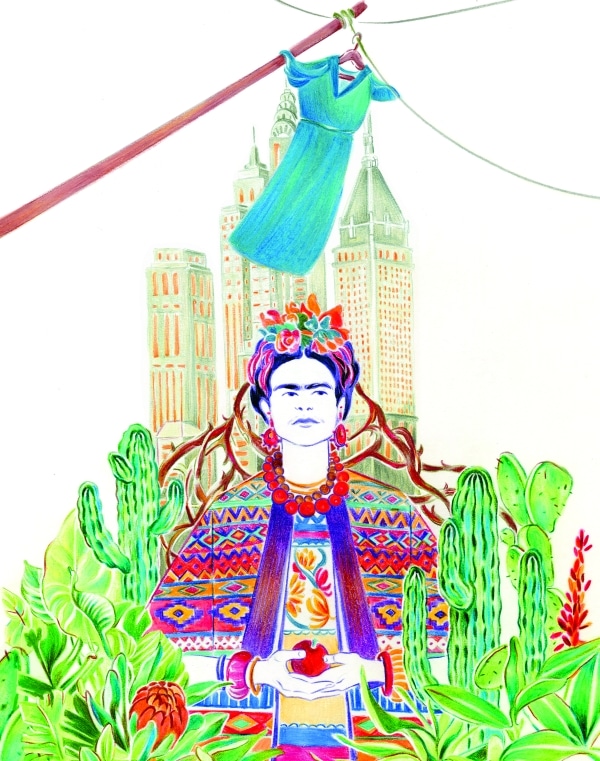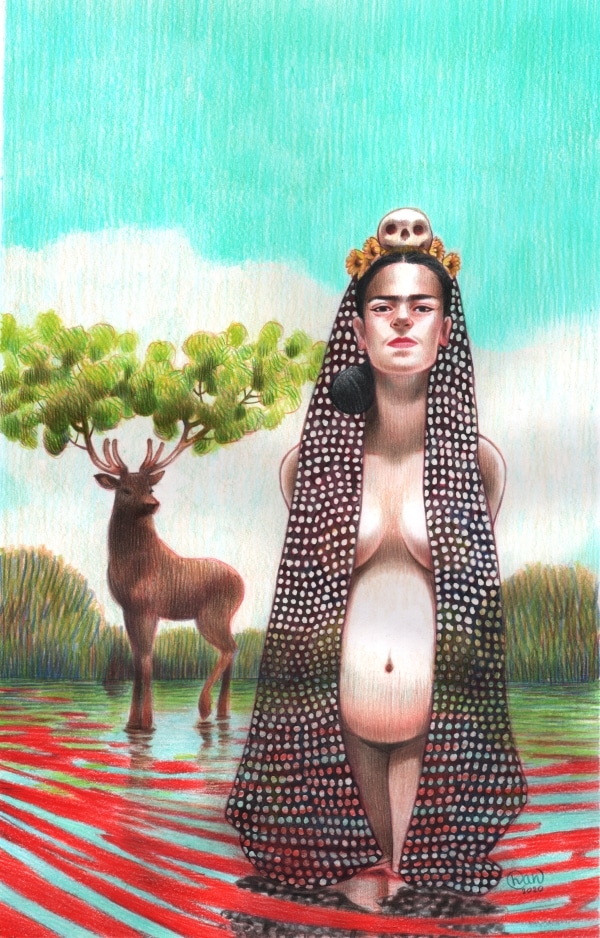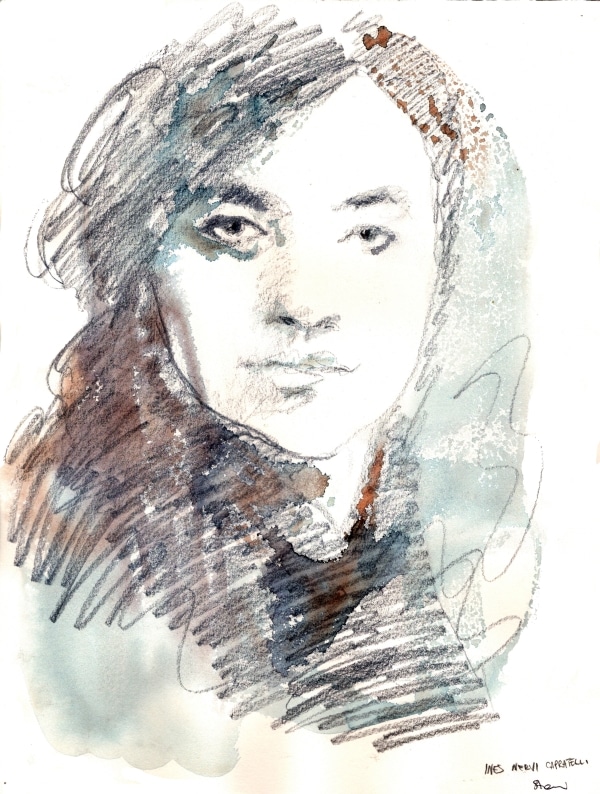FRIDA AND THE WOMEN
OF CALABRIA
The exhibition Frida and the women of Calabria creates a parallelism between Frida Khalo's art and personality and the women who belong to a particular social context in Calabria: the central ideas are emancipation, vindication of rights, women's professional success. Frida Khalo, known both for her art and her strong and risolved nature, was always independent and nonconformist, in constant struggle with life. Her personality can be perceived in many other women, who are capable of succeeding in a rough, fragile place like Calabria. Women connected by an invisible thread, in spite of geographical and temporal differences; women who are able to communicate within the exhibition, which is divided in two sections: the first one - featuring the illustrations of artists like Grazia La Padula, Anna Cercignano, Adele Ceraudo, La Tram, Arianna Rea - is dedicated to Frida and her stunning life; the second one features Beppe Stasi's artworks and it is dedicated to the faces of the women of Calabria, who stand out for their strong, determined personality, often going fearlessly against the grain, freely living their passions, just like Frida. divisa in due sezioni: la prima, con le illustrazioni delle artiste Grazia La Padula, Anna Cercignano, Adele Ceraudo, La Tram, Arianna Rea, dedicate a Frida e alla sua sconvolgente vita. La seconda sezione è dedicata alle opere di Beppe Stasi, e i volti delle donne di Calabria, capaci di distinguersi per il carattere forte e deciso, andando spesso controcorrente senza timore, vivendo liberamente le loro passioni, proprio come Frida.
Artworks by Adele Ceraudo, Anna Cercignano, Grazia La Padula, La Tram, Arianna Rea, Beppe Stasi
Critical texts of Federica Cananzi
Frida seen by La Tram

Wrapped into a lush vegetation, among cactuses, prickly pears and many other Mexican plants, Frida Khalo's figure stands solemnly: her back strait, she is looking upwards, holding an apple in her hands. Her clothes are full of eclectic colours, with geometrical and floral patterns, so as the tiara on her head. Lavish bracelets, necklaces and earrings enrich Frida's mighty figure. Behind her head, thorny branches spread, and finally New York's skyline in the background gives the setting. At the top of the picture, a light blue dress hanging on a clothesline floats in the air. During her stay in America, Frida starkly stood out from American society and women: for her ideas, her irreverent and independent personality, and her way of dressing. In these period, the expression of her Mexican identity, clothes and tradition was very strong, and she embodied her own culture,not tainted by the American carefree spirit, charming the people she met. Free from the formalities of the post-colonialist society, Frida gently twirls like the light blue dress, staying connected to the simplicity of her South American origins.
Frida seen by Anna Cercignano

Artist Anna Cercignano's illustration shows Frida pregnant, immersed in nature, where reality merges with imagination. Frida is in the foreground, in a solemn, statuary pose, her body transformed by maternity; its accentuated shapes elegantly emphasize her femininity. She wears a floral tiara with a skull in the middle, her hair is up and a long veil reaches out to her breasts. Frida's gaze is glacial, far from the joy of pregnancy. She's on her knees, her hands probably folded behind her back, as a symbol of penitence. The water spectre her knees rest on is bloodstained, while on the left a deer, walking with a solemn gaze, stares at her. Its antlers have turned into trees, creating a surreal vision, widely used by Frida herself in her works. The deer represents hope towards life. The backgorund setting seems to be contradictory: a reassuring, clear sky and some bushes define the line of the horizon but Frida's gaze and the redness of the stained water brutally break that harmony. What emphasizes the contrast with the setting is the upper part of the picture, where dark, purplish vegetal elements are inserted, and a ribbon that says “Viva la Vida”, which is what Frida wrote in the last period of her life, when she understood she was close to the end, like a rabid scream full of love for life. Frida fought against a desire which is often natural for a woman: to become a mother, which unfortunately could never be fulfilled due to a serious accident in 1925 that severely compromised her spine. The blood in the picture recalls her miscarriages, the painful, always suffered loss.
Ines Nervi seen by Beppe Stasi

Clear, strong marks, a fierce gaze fixed on the viewer: this is how Beppe Stasi decides to portray Calabrian woman Ines Nervi. Cold and conflicting tones emphasize the depth of her gaze. Her portrait reveals her personality: determined, firm, highly committed to the respect for the rules. Her political commitment is strongly related to the territory, specially as regards to female empancipation. During the first local election after the war, she was running for mayor for the Christian-Democratic party, and she obtained great consensus. In those days, social tension was extremely high, between the democratic opening and the conservative views, besides the problems arisen after the fascist regime. There were many protests, mainly supported by the Italian Communist party, the historical opponent of the Christian-Democratic party, on the grounds that she couldn't play a highly representative public role while working as a teacher. In spite of such protests, during her term she carried out some important public works, from the city sewage to the flooring of the main road that connected and still connects Piazza IV Novembre and Piazza Margherita. Moreover, she engaged in the improvement of the livability of the old town through a work of urban redevelopment, and she struggled to find a job to many unemployed citizens. In 1946 three Calabrian women were elected mayor: Caterina Tufarelli Palumbo, mayor of San Sosti (CS), first female mayor in Italia, Lydia Serra Toraldo, mayor of Tropea, and Ines Nervi. All of them belonged to the Christian-Democratic party: a sign of the wind of change, in a challenging historical and social context.
The exhibit continues...
In exposition at the Comics Museum till 21 May 2023
You can find us in Cosenza, in Street Liceo 1.
We are open every day, except Mondays, from 16.00 to 19.30
